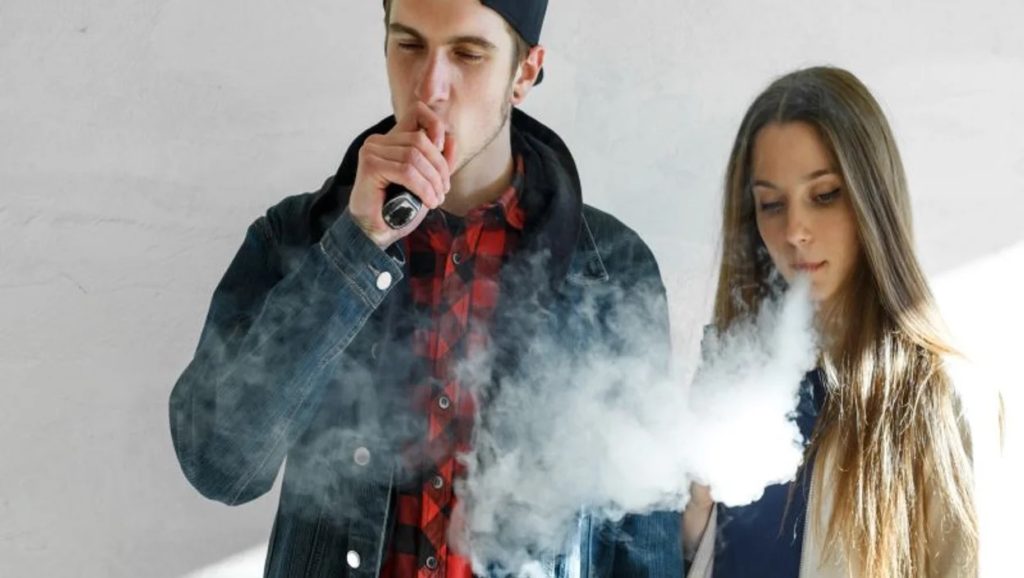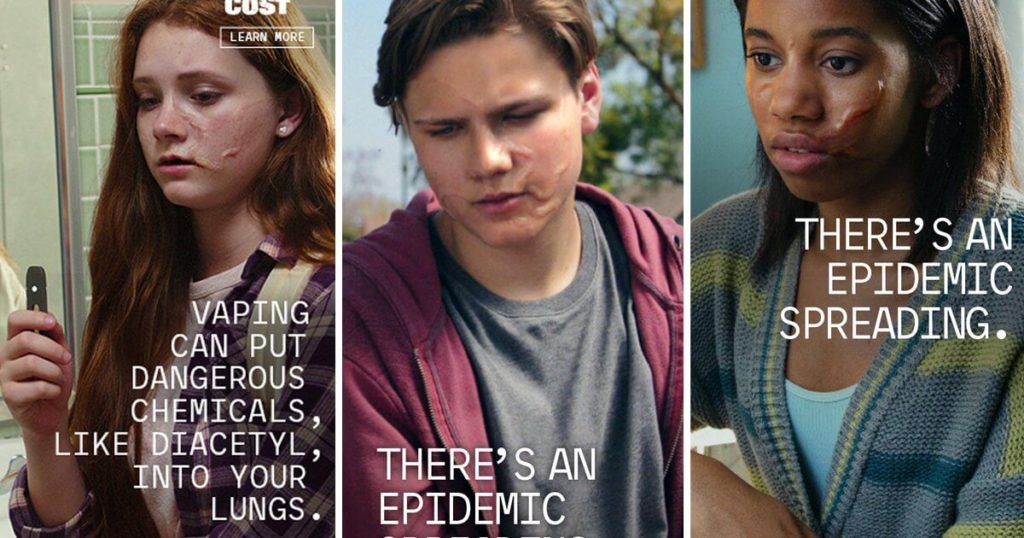A Virtual Recognition for the Fight Against Nevada’s Hidden Health Crisis –Youth Vaping


The Nevada Tobacco Prevention Coalition (NTPC) will host a virtual event with prominent speakers and experts who will discuss the skyrocketing issue of teen vaping in Nevada. This exclusive media event will include information parents can use to detect, recognize signs and start the conversation with their children. Additionally, Hillary Bunker from Attorney General Aaron Ford’s office and Senator Julia Ratti will show their support by recognizing January 26 as Youth Vaping Prevention and Awareness Day. The special event schedule will be as follows:
12 – 12:10 p.m. “Why Nevadans Should Care”
with Kelli Seals, President of Nevada Tobacco Prevention Coalition
12:10 – 12:25 p.m. “Vaping Issue and How It’s Affecting Our Youth”
with Jennifer L. Pearson, PhD MPH
12:25 -12:35 p.m. “What Parents Can Do”
with Malcolm Ahlo, Tobacco Prevention and Control at Southern Nevada Health District
12:35 – 12:40 p.m. “What Your Attorney General is Doing to Protect Kids from Underage Smoking” with Hillary Bunker, Supervising Senior Deputy Attorney General, Office of the Nevada Attorney General Tobacco Enforcement Unit
12:40 – 12:50 p.m. “Recognition of Youth Vaping Prevention and Awareness Day”
with Senator Julia Ratti
12:50 – 1 p.m. “Q&A”
with Media
WHEN: Tuesday, January 26 at 12 p.m. PST
WHERE: Zoom
MEDIA: Media interested in attending, should RSVP to grace.russell@braintrustagency.com to confirm spot and receive Zoom link by Monday, January 25.
ABOUT: Nevada Tobacco Prevention Coalition (NTPC) is a collaboration of organizations and individuals that work in public health, health care, local and national nonprofits, community-based organizations, insurance payors, professional and medical associations, higher education, and government. NTPC has put together a five-part public education campaign, branded “Behind the Haze” and “Let’s Talk Vaping”, to educate teens and adults about the dangers of vaping and unveil the unethical tactics of the vaping industry. Through campaign messaging, statewide partnerships and collaborations, NTPC hopes to reduce the overall use of youth vaping in Nevada.
U.S. Centers for Disease Control and Prevention, U.S. Food and Drug Administration, news releases, Sept. 9, 2020
The number of U.S. youths who use e-cigarettes fell from 5.4 million in 2019 to 3.6 million this year — but vaping remains a dangerous epidemic among children and teens, a new government report shows.
“Although the decline in e-cigarette use among our nation’s youth is a notable public health achievement, our work is far from over,” Dr. Robert Redfield, director of the U.S. Centers for Disease Control and Prevention, said in an agency news release. “Youth e-cigarette use remains an epidemic, and [the] CDC is committed to supporting efforts to protect youth from this preventable health risk.”
The analysis of National Youth Tobacco Survey data also found that 8 in 10 current youth vapers use flavored e-cigarettes. The use of fruit, mint and menthol flavors of e-cigarettes was common among young users.
The survey of U.S. middle schoolers and high school students was conducted from Jan. 16 to March 16, and the findings were analyzed by researchers from the CDC and the U.S. Food and Drug Administration.
The data show that 19.6% of high school students and 4.7% of middle school students used e-cigarettes in 2020, down from 27.5% and 10.5%, respectively, in 2019.
As in 2019, pre-filled pods/cartridges were the most commonly used device type among youth e-cigarette users in 2020. However, from 2019 to 2020, disposable e-cigarette use increased from 2.4% to 26.5% (a 1,000% increase) among high school e-cigarette users and from 3% to 15.2% (a 400% increase) among middle school e-cigarette users.
The findings were published Sept. 9 in the CDC’s Morbidity and Mortality Weekly Report.
“These findings reinforce the importance of continuing to focus on the strategies that work to reduce youth tobacco product use while keeping pace with emerging trends in tobacco products,” said Dr. Karen Hacker, director of CDC’s National Center for Chronic Disease Prevention and Health Promotion.
“Implementing these strategies at the national, state and local levels is integral to preventing and reducing youth tobacco product use, including e-cigarettes,” Hacker added in the release.
While the decline in youth vaping is good news, “the FDA remains very concerned about the 3.6 million U.S. youth who currently use e-cigarettes and we acknowledge there is work that still needs to be done to curb youth use. Youth use of e-cigarettes remains a public health crisis … and we will do everything possible to stop it, including new actions we are taking today,” FDA Commissioner Dr. Stephen Hahn said in an FDA news release.
“The findings come as we mark today’s premarket review submission deadline, a milestone for ensuring new tobacco products, including many already on the market, undergo a robust scientific evaluation by the FDA. Scientific review of new products is a critical part of how we carry out our mission to protect the public — especially kids — from the harms associated with tobacco use,” Hahn said.
More information
The U.S. Surgeon General has more on the risks of e-cigarettes to youth. SOURCES: U.S. Centers for Disease Control and Prevention, U.S. Food and Drug Administration, news releases, Sept. 9, 2020
————————————————————–
This article was published in July 2019 on Survivor net:

The FDA Announced Major New Campaign to Curb Youth Vaping– Will Fake Skin Parasites, Magic Tricks & Bathroom Posters Make a Difference?
“You might as well flush your lungs while you’re at it,” is one of the lines from the new government sponsored ad campaign to raise awareness among young people about the dangers of vaping. The campaign also includes posters featuring teenagers with bulging, linear scars on their faces. As some snarky folks pointed out today, the new effort could very well make the often ridiculed “Just say no to drugs” campaign from the 1980s look like an Oscar winner.
As part of its ongoing effort to curb youth vaping, the U.S. Food and Drug Administration (FDA) has just announced that it will air educational TV ads about the dangers of using e-cigarettes. The TV ads, along with a series of posters that will be displayed in high schools and middle schools across the country, are part of the FDA’s “The Real Cost” Youth E-Cigarette Prevention Campaign, a $60 million effort.
The campaign initially launched in September, mainly targeting social media and digital sites. Some of the most striking ads featured images of teens with parasites beneath their skin. While parasites aren’t themselves a known side effect of e-cigarettes, the FDA’s message was one of comparison: teen vaping is spreading like a parasite.
The existing ads are now joined by the new TV ads and posters, which are expected to reach the nearly 10.7 million youth between the ages of 12 and 17 who have either used e-cigarettes or are open to the idea of using them.
The ramped-up efforts come on the tails of 2018’s National Youth Tobacco Survey, which found that more than 3.6 million middle and high school students nationwide had used e-cigarettes within the past 30 days. The number is more than double that of the previous year, 1.5 million students.
According to the FDA’s press release about the new ads and posters, the agency’s similar effort for traditional cigarettes, “The Real Cost” Cigarette Prevention Campaign, successfully prevented 350,000 youth from taking up smoking and has saved the country over $31 billion in medical costs as well as the lost wages, lower productivity, and increased instances of disability that come with smoking-related health conditions, including lung cancer.
As E-Cigarette Companies Receive Pushback for Youth-Friendly Marketing, Questions About Safety Remain
The wildly successful companies that produce and sell e-cigarette devices, especially JUUL Labs, which makes the most popular of the bunch, the JUUL, claim that their products are meant only as an alternative to cigarettes for adult smokers.
But the colorful, teen-friendly marketing and fruity flavors have raised doubt about these claims, and the companies have been under fire from the FDA for intentionally marketing their products to America’s youth.
RELATED: The Issue With Vaping — Doctors Don’t Know How Dangerous It Is Yet
The companies market the products as “safer” because they do not contain tobacco and several other carcinogens in cigarettes that are known to cause lung cancer. But while e-cigarettes do not contain tobacco, the nicotine liquid they contain is made with a number of other chemicals and metal particles, which could potentially have dangerous long-term health effects, too. The question as to whether these chemicals and particles will ultimately lead to lung cancer remains unknown simply because it is too early to tell. Cancer can take decades to develop, and the research needed to prove a link will not surface until then.
“Vaping is still in its infancy,” Dr. Raja Flores, Chairman of the Department of Thoracic Surgery at Mount Sinai Health System, told SurvivorNet in a previous conversation about e-cigarettes. “In order to prove something causes cancer, you need a large number of people and a longer period of time.”
The FDA press release has shared several examples of the messaging it plans to use on the posters in school bathrooms (where many teens sneak off to use e-cigarettes). One example is, “You might as well flush your lungs while you’re at it. Vaping can deliver toxic metal particles, like nickel, lead and chromium directly into your lungs.” Another is, “When you find out what’s in a vape, you won’t be relieved. Vaping can expose you to some of the same cancer-causing chemicals as those found in cigarette smoke.”
As for the TV ads, the FDA has shared one called “Magic,” in which the popular magician and social media personality Julius Dein turns an e-cigarette into a traditional cigarette in front of a group of laughing teens. The video then shares that teens who use e-cigarettes are far more likely to take up smoking traditional cigarettes than teens who do not use e-cigarettes are, a statistic that was published in the Journal of the American Medical Association this past February.
RELATED: “Secret Shoppers”– JUUL Tries To Clear its Name By Sending Fake Shoppers To Spy On Sellers
“The troubling epidemic of youth vaping threatens to erase the years of progress we’ve made combatting tobacco use among kids,” Dr. Ned Sharpless, Acting Commissioner of the FDA, said in the press release for the new ads. “It’s imperative that our work to tackle this immensely concerning trend continue to include efforts to educate our nation’s youth about the dangers of these products.”